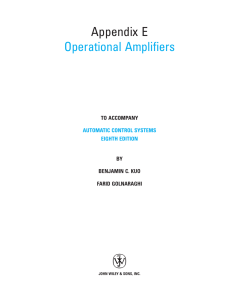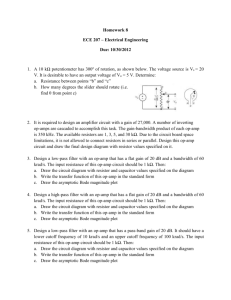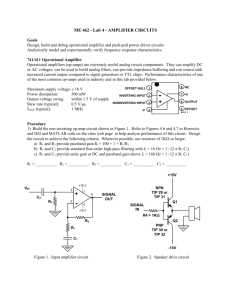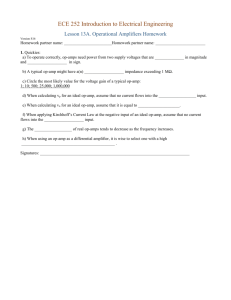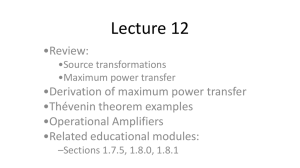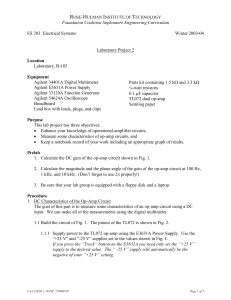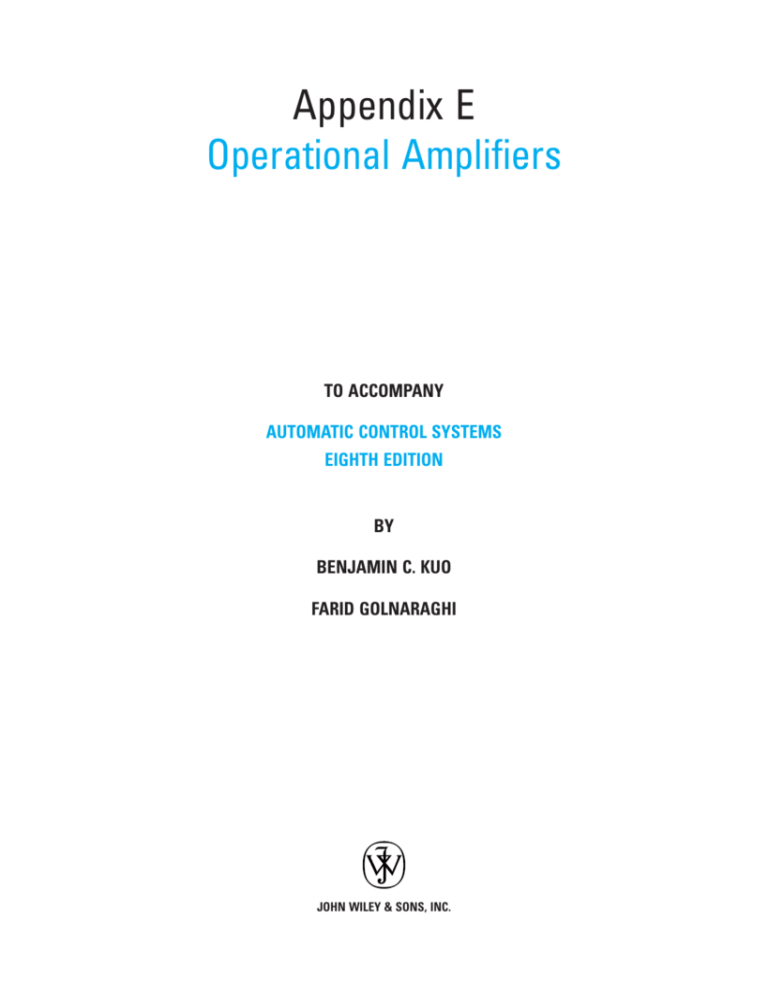
Appendix E
Operational Amplifiers
TO ACCOMPANY
AUTOMATIC CONTROL SYSTEMS
EIGHTH EDITION
BY
BENJAMIN C. KUO
FARID GOLNARAGHI
JOHN WILEY & SONS, INC.
Copyright © 2003 John Wiley & Sons, Inc.
All rights reserved.
No part of this publication may be reproduced, stored in a retrieval system or transmitted
in any form or by any means, electronic, mechanical, photocopying, recording, scanning
or otherwise, except as permitted under Sections 107 or 108 of the 1976 United States
Copyright Act, without either the prior written permission of the Publisher, or
authorization through payment of the appropriate per-copy fee to the Copyright
Clearance Center, 222 Rosewood Drive, Danvers, MA 01923, (508)750-8400, fax
(508)750-4470. Requests to the Publisher for permission should be addressed to the
Permissions Department, John Wiley & Sons, Inc., 605 Third Avenue, New York, NY
10158-0012, (212) 850-6011, fax (212) 850-6008, E-Mail: PERMREQ@WILEY.COM.
To order books or for customer service please call 1-800-CALL WILEY
(225-5945).
ISBN 0-471-13476-7
APPENDIX
E
Operational Amplifiers
E-1 OPERATIONAL AMPLIFIERS
MATLAB
E-1-1
Operational amplifiers, or simply op-amps, offer a convenient way to build, implement,
or realize continuous-data or s-domain transfer functions. In control systems, op-amps are
often used to implement the controllers or compensators that evolve from the controlsystem design process, so in this appendix we illustrate common op-amp configurations.
An in-depth presentation of op-amps is beyond the scope of this text. For those interested,
many texts are available that are devoted to all aspects of op-amp circuit design and
applications [References 1 and 2].
Our primary goal here is to show how to implement first-order transfer functions with
op-amps, while keeping in mind that higher-order transfer functions are also important.
In fact, simple high-order transfer functions can be implemented by connecting first-order
op-amp configurations together. Only a representative sample of the multitude of op-amp
configurations will be discussed.
Some of the practical issues associated with op-amps are demonstrated in simlab (see
Chapter 11).
The Ideal Op-Amp
When good engineering practice is used, an op-amp circuit can be accurately analyzed by
considering the op-amp to be ideal. The ideal op-amp circuit is shown in Fig. E-1, and
has the following properties:
The voltage between the and terminals is zero, that is, e e. This property is commonly called the virtual ground or virtual short.
2. The currents into the and input terminals are zero. Thus, the input impedance is infinite.
3. The impedance seen looking into the output terminal is zero. Thus, the output is
an ideal voltage source.
1.
The input-output relationship is eo A(e e) where the gain A approaches
infinity.
4.
–
+
+
e–
–
+
+
e+
eo
–
–
Figure E-1 Schematic diagram of an op-amp.
E-1
E-2 Appendix E Operational Amplifiers
The input-output relationship for many op-amp configurations can be determined by
using these principles. An op-amp cannot be used as shown in Fig. E-1. Rather, linear operation requires the addition of feedback of the output signal to the input terminal.
E-1-2
Sums and Differences
As illustrated in the last chapter, one of the most fundamental elements in a block
diagram or an SFG is the addition or subtraction of signals. When these signals are
voltages, op-amps provide a simple way to add or subtract signals as shown in Fig. E-2,
R
ea
+
R
R
–
–
+
+
+
eb
eo = –(ea + eb)
–
–
(a)
R
R
–
+
R
ea
+
–
+
R
eo = ea + eb
+
eb
–
–
(b)
R
ea
R
+
–
–
+
R
+
+
eb
–
eo = eb – ea
R
–
(c)
Figure E-2 Op-amps used to add
and subtract signals.
E-1 Operational Amplifiers E-3
where all the resistors have the same value. Using superposition and the ideal properties given in the preceding section, the input-output relationship in Fig. E-2(a) is vo (va vb). Thus, the output is the negative sum of the input voltages. When a positive sum is desired, the circuit shown in Fig. E-2(b) can be used. Here the output is
given by eo ea eb.
Modifying Fig. E-2(b) slightly gives the differencing circuit shown in Fig. E-2(c),
which has an input-output relationship of eo eb ea.
E-1-3
First-Order Op-Amp Configurations
In addition to adding and subtracting signals, op-amps can be used to implement transfer
functions of continuous-data systems. While many alternatives are available, we will
explore only those that use the inverting op-amp configuration shown in Fig. E-3. In the
figure, Z1(s) and Z2(s) are impedances commonly composed of resistors and capacitors.
Inductors are not commonly used because they tend to be bulkier and more expensive.
Using ideal op-amp properties, the input-output relationship, or transfer function, of the
circuit shown in Fig. E-3 can be written in a number of ways, such as
G1s2 Eo 1s2
Z2 1s2
1
Ei 1s2
Z1 1s2
Z1 1s2Y2 1s2
Z2 1s2Y1 1s2 (E-1)
Y1 1s2
Y2 1s2
where Y1(s) 1Z1(s) and Y2(s) 1Z(s) are the admittances associated with the circuit
impedances. The different transfer function forms given in Eq. (E-1) apply conveniently
to the different compositions of the circuit impedances.
Using the inverting op-amp configuration shown in Fig. E-3 and using resistors
and capacitors as elements to compose Z1(s), and Z2(s), Table E-1 illustrates a number
of common transfer function implementations. As shown in the Table E-1, it is possible to implement poles and zeros along the negative real axis as well as at the origin
in the s-plane. Because the inverting op-amp configuration was used, all the transfer functions have negative gains. The negative gain is usually not an issue, since it
is simple to add a gain of 1 to the input and output signal to make the net gain
positive.
Z2(s)
+
Ei (s)
–
Z1(s)
–
+
+
Eo(s)
–
Figure E-3 Inverting op-amp configuration.
E-4 Appendix E Operational Amplifiers
TABLE E-1
Inverting Op-Amp Transfer Functions
Input
Element
(a)
R1
R2
Z1 = R1
Z2 = R2
R1
(b)
Feedback
Element
Transfer
Function
R2
R1
Inverting gain. e.g., if
R1 R2, eo e1.
1 1
b
R1C2 s
Pole at the origin. i.e.,
an integrator.
(R2C1)s
Zero at the origin. i.e.,
a differentiator.
C2
a
Z1 = R1
Comments
Y2 = sC2
C1
R2
(c)
Y1 = sC1
Z2 = R2
R2
(d)
1
R1C2
1
s
R2C2
R1
Z1 = R1
R1
C2
Y2 = 1 + sC2
R2
R2
C2
(e)
Z1 = R1
Z2 = R2 + 1
sC2
R2 s 1R2C2
b
a
s
R1
Pole at the origin and a
zero at 1R2C2,
i.e., a PI Controller.
R2C1 as Zero at s R1
R2
(f )
C1
1
Y1 =
+ sC1
R1
(g)
Z2 = R2
R1
R2
C1
Y1 = 1 + sC1
R1
C2
Y2 = 1 + sC2
R2
1
with a dc
R2C2
gain of R2R1.
Pole at
1
b
R1C1
1
C1
as b
C2
R1C1
1
s
R2C2
1
, i.e.,
R1C1
a PD controller.
1
and a
R2C2
1
zero at s ,
R1C1
i.e., a lead or lag
controller.
Pole at s EXAMPLE E-1 As an example of op-amp realization of transfer functions, consider the transfer function
MATLAB
G1s2 Kp KI
KDs
s
(E-2)
where KP, KD, and KI are real constants. In Chapter 10 this transfer function will be called the PID
controller, since the first term is a Proportional gain, the second an Integral term, and the third a
Derivative term. Using Table E-1, the proportional gain can be implemented using line (a), the integral term can be implemented using line (b), and the derivative term can be implemented using
line (c). By superposition, the output of G(s) is the sum of the responses due to each term in G(s).
This sum can be implemented by adding an additional input resistance to the circuit shown in Fig.
E-2(a). By making the sum negative, the negative gains of the proportional, integral, and derivative
E-1 Operational Amplifiers E-5
R2
R1
–
KP
Ep(s)
+
R
Ci
Ri
E(s)
R
–
–
KI
EI (s)
+
R
Eo(s)
+
Rd
Cd
–
KD
+
ED (s)
R
Figure E-4 Implementation of a PID controller.
term implementations are canceled, giving the desired result shown in Fig. E-4. The transfer functions of the components of the op-amp circuit in Fig. E-4 are
Proportional:
EP 1s2
Integral:
EI 1s2
Derivative:
ED 1s2
Rd Cds
E1s2
E1s2
E1s2
R2
R1
(E-3)
1
RiCis
(E-4)
(E-5)
The output voltage is
Eo 1s2 3EP 1s2 EI 1s2 ED 1s2 4
(E-6)
Thus, the transfer function of the PID op-amp circuit is
G1s2 Eo 1s2
E1s2
R2
1
Rd Cds
R1
RiCis
(E-7)
By equating Eqs. (E-2) and (E-7), the design is completed by choosing the values of the resistors and the capacitors of the op-amp circuit so that the desired values of KP, KI, and KD are
matched. The design of the controller should be guided by the availability of standard capacitors
and resistors.
It is important to note that Fig. E-4 is just one of many possible implementations of Eq. (E-2).
For example, it is possible to implement the PID controller with just three op-amps. Also, it is common to add components to limit the high-frequency gain of the differentiator and to limit the integrator output magnitude, which is often referred to as antiwindup protection. One advantage of the
implementation shown in Fig. E-4 is that each of the three constants KP, KI, and KD can be adjusted
or tuned individually by varying resistor values in their respective op-amp circuits.
E-6 Appendix E Operational Amplifiers
Op-amps are also used in control systems for AD and DA converters, sampling devices, and
realization of nonlinear elements for system compensation.
REFERENCES
1. E. J. Kennedy, Operational Amplifier Circuits, Holt, Rinehart and Winston, Fort Worth, TX, 1988.
2. J. V. Wait, L. P., Huelsman, and G. A. Korn, Introduction to Operational Amplifier Theory and
Applications, Second Edition, McGraw-Hill, New York, 1992.
PROBLEM
E-1.
Find the transfer functions Eo(s)E(s) for the circuits shown in Fig. EP-1.
R2
C1
R1
+
–
+
E(s)
+
–
(a)
Eo(s)
–
R2
C2
C1
+
–
+
E(s)
R1
+
–
(b)
Eo(s)
–
RF
+
R1
–
R2
E(s)
–
C
+
+
–
C
+
E(s)
–
(c)
Eo(s)
RF
R1
–
+
R2
+
(d)
Eo(s)
–
Figure EP-1


